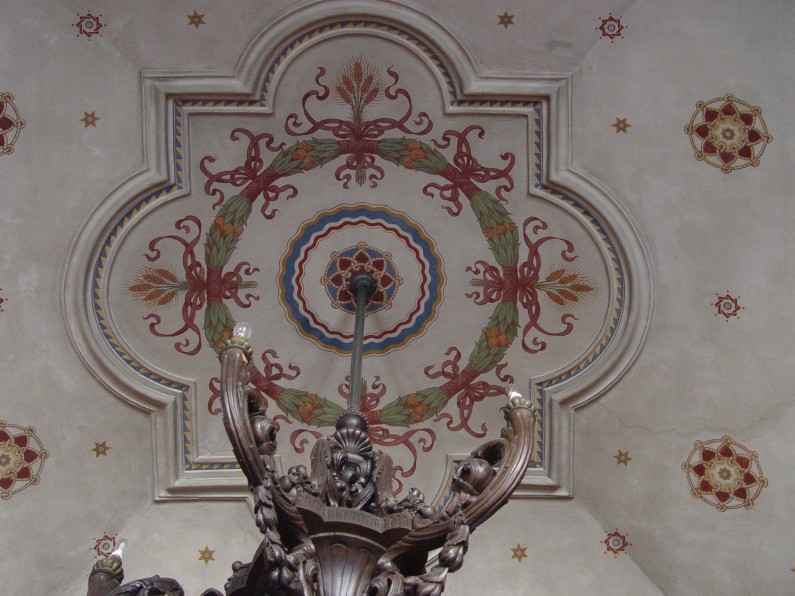
The ground floor of the18th-century wing is composed of 11 rooms and as a result of numerous modifications of the previous décor in the earlier years, its final appearance was completed between the years 1784 and 1796, and which we know of today only because of the inventories taken in the first half of the18th century by the Visconti Litta family.
More
The small room today referred to as “Antechamber/Foyer” functioned as an entrance to the rooms assigned to the activities of the noble families that owned it and was accessed via a grand staircase, which is currently not accessible; this led to the upper floors. To date, the furniture consists of a monobloc closet safe of the turn of the 19th-century period, a 19th-century icebox and a wrought iron chandelier.
The adjacent “Hall of virtue” was commissioned two years after the death of Julius Borromeo Visconti, by his two heirs and daughters married to members of the Litta clan, and is described in the inventory as a room that was occupied by a large portrait done by an unknown artist, and by other eight portraits made for the House of Litta by “Cavalier Rusca.” This room had a large stone fireplace that may be rightly identified as the original one since the date 1722 is written on the plate placed on the back wall. Both the chimney and the walls are decorated with laurel wreaths and ribbons that encircle emblems within which, against a red background are the words “Love,” “Virtue,” “Honour,” “Praise” and “Glory,” hence the name of the room.
The nearby “Hall of the Sun,” renovated in 2007, is decorated on the right wall by a large pink marble fireplace. The room takes its name from the fresco in the centre of the ceiling, depicting the ” Visconti raza” or irradiation symbol with the radiant sun, which was the emblem of the Visconti family. Used as his own by Gian Galeazzo Visconti, the “raza” or “radia magna” in the Renaissance period was used as a symbol of the power radiated by the Duke of Milan, for he, like the sun, was a source of life for his subjects and a symbol of righteousness, because as the sun separates light from darkness, the lord of Milan practiced justice by separating good from evil. After legitimizing his power in 1395, Gian Galeazzo transcended the human condition to take on the divine, as ruler and the emperor himself: his image was then likened to that of Christ the King, the sun of righteousness, which, at sunrise illuminated the Cathedral (the irradiation symbol appears in fact at the centre of the central window of the apse) when it rose. The 18th-century villa of Lainate certainly intended to celebrate the splendour achieved by this Visconti who transformed a fiefdom into a real kingdom complete with a line of heirs.
The adjacent “Hall of virtue” was commissioned two years after the death of Julius Borromeo Visconti, by his two heirs and daughters married to members of the Litta clan, and is described in the inventory as a room that was occupied by a large portrait done by an unknown artist, and by other eight portraits made for the House of Litta by “Cavalier Rusca.” This room had a large stone fireplace that may be rightly identified as the original one since the date 1722 is written on the plate placed on the back wall. Both the chimney and the walls are decorated with laurel wreaths and ribbons that encircle emblems within which, against a red background are the words “Love,” “Virtue,” “Honour,” “Praise” and “Glory,” hence the name of the room.
The nearby “Hall of the Sun,” renovated in 2007, is decorated on the right wall by a large pink marble fireplace. The room takes its name from the fresco in the centre of the ceiling, depicting the ” Visconti raza” or irradiation symbol with the radiant sun, which was the emblem of the Visconti family. Used as his own by Gian Galeazzo Visconti, the “raza” or “radia magna” in the Renaissance period was used as a symbol of the power radiated by the Duke of Milan, for he, like the sun, was a source of life for his subjects and a symbol of righteousness, because as the sun separates light from darkness, the lord of Milan practiced justice by separating good from evil. After legitimizing his power in 1395, Gian Galeazzo transcended the human condition to take on the divine, as ruler and the emperor himself: his image was then likened to that of Christ the King, the sun of righteousness, which, at sunrise illuminated the Cathedral (the irradiation symbol appears in fact at the centre of the central window of the apse) when it rose. The 18th-century villa of Lainate certainly intended to celebrate the splendour achieved by this Visconti who transformed a fiefdom into a real kingdom complete with a line of heirs.
